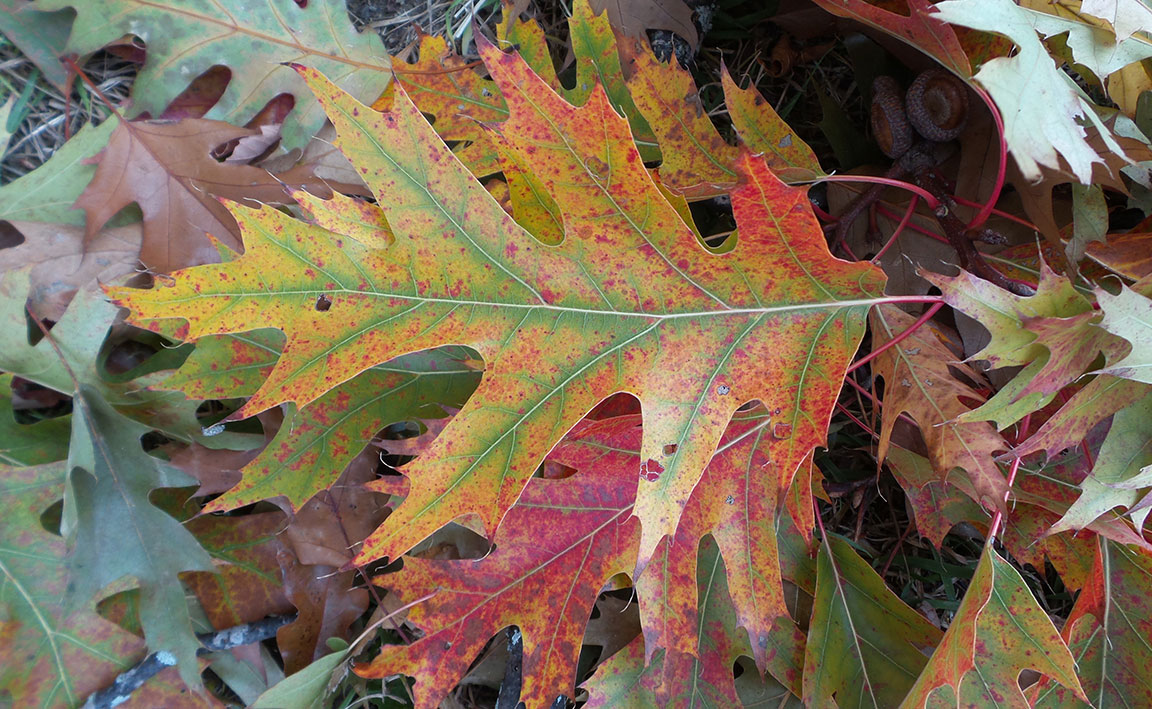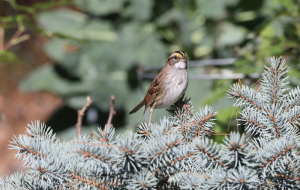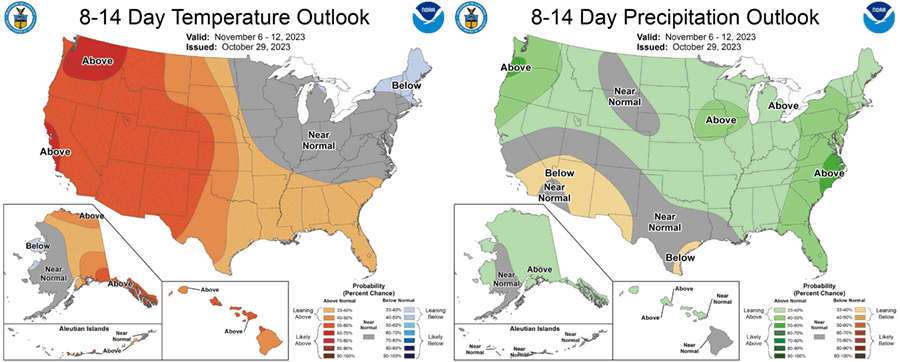
Maine Home Garden News–November 2023
In This Issue:
- November Is the Month to . . .
- Backyard Bird of the Month–White-throated Sparrow
- Put Culture Back into Agriculture
- Roasted Garlic Brussels Sprouts
- Finding Joy in a Hard Gardening Year
- Ask the Expert Q&A
- Maine Weather and Climate Overview (November)
- Gifts for the Gardener
November Is the Month to . . .
By Shelby Hartin, Penobscot County Master Gardener Volunteer
Harvest what’s left and clean up the rest. Cleaning up your garden and pulling dead plants is important, especially if you observed issues with pests or diseases this season. Some insects and pathogens can overwinter in plant material that’s left behind. Don’t remove spent perennial stems that are sturdy, such as the stems of coneflowers – they can become an important winter habitat for bees and a food source for birds.
Test your soil. A soil test will give you recommendations for your next growing season. Take a sample anytime before the ground freezes. See Bulletin 2286, Know Your Soil: Testing Your Soil. Results will be the same whether you test in spring or fall, but knowing what’s needed now will give you a head start on gathering soil amendments for next season. It usually takes two to three weeks before you get your results.
 Compost! Those Halloween pumpkins that have started to rot on your porch are great candidates for the compost. See Bulletin 1143, Home Composting. If you rake your leaves (think twice: fallen leaves are an important habitat for wildlife and they suppress weeds!), you can also use them for compost. Think about balancing the carbon and nitrogen materials in your compost for the best decomposition. Don’t add any plants that may have been diseased or weeds that have gone to seed.
Compost! Those Halloween pumpkins that have started to rot on your porch are great candidates for the compost. See Bulletin 1143, Home Composting. If you rake your leaves (think twice: fallen leaves are an important habitat for wildlife and they suppress weeds!), you can also use them for compost. Think about balancing the carbon and nitrogen materials in your compost for the best decomposition. Don’t add any plants that may have been diseased or weeds that have gone to seed.
Winterize sprinklers, store your hoses and protect your outdoor faucets. Drain your sprinkler systems and unhook your hoses to prevent damage. Also, consider protecting your outdoor faucets with insulated covers.
Finish your garden clean up. Store your tomato cages and trellises, bring decorative garden ornaments inside, and protect any other materials that may be susceptible to cold. Be sure to empty container garden pots or store them inside to avoid freezing and cracking.
Clean your tools. Cleaning your tools can help extend their useful life. Remove all the soil and other debris on the tools with water. A stiff brush can help remove anything left afterward. Coarse steel wool can get rid of remaining rust. Wipe with a dry cloth, and consider using a light coat of motor oil on metal heads to prevent more rust buildup.
Preserve your harvest. November is a great time to preserve what’s left of your harvest. For tips and tricks, check out the extension’s food preservation publications.
Soak up the autumn sun. Don’t forget to enjoy the final days of fall before the snow arrives. Daydreaming about next year’s garden while on a morning walk with a cup of coffee and a warm coat is an ideal task for November.
Need more tips? Check out this video about preparing your garden for winter, and consider tuning in here for information about preserving your harvest.
Backyard Bird of the Month–White-throated Sparrow
By Andy Kapinos, Maine Audubon Field Naturalist

Depending on where you live in the state, you will either be saying goodbye to or welcoming White-throated Sparrows during November. In September, these common sparrows start heading south from breeding territory in Canada and northern New England, where they can be found throughout the summer, singing their characteristic “Oh sweet Canada, Canada, Canada” song. By the end of November, they are mostly gone from the North Woods, and the northernmost overwintering White-throated Sparrows remain in central and coastal Maine. Their white throats, contrasting a gray breast, and bold crown stripes with a yellow spot in front of the eye are usually enough to distinguish them from similar species. They frequent feeders in the winter, often foraging for seeds on the ground with Song and American Tree Sparrows. These birds exhibit a dimorphism that is believed to be unique among birds: whereas many species are sexually dimorphic (males and females have different plumage and behavior), White-throated Sparrows have two morphs that are not sexually determined. White-striped morphs have highly contrasting white and black head stripes and are generally more tenacious, and tan-striped morphs have tan and brown head stripes and are generally more submissive. A bird of one morph will almost always mate with a bird of the opposite morph, ensuring the continuation of this unique dimorphism. Keep an eye out for these unique birds under your feeders this winter!
For more on the importance of planting Maine native plants to support birds like the White-throated Sparrow and other wildlife, visit Maine Audubon’s “Bringing Nature Home” webpage.
Put Culture Back into Agriculture
Make your voice heard and help support the Ujamaa Cooperative Farming Alliance to put culture back into agriculture.
The Ujamaa Cooperative Farming Alliance (Ujamaa) is a BIPOC (Black, Indigenous, and People of Color)-led collective seeking to increase grower and crop varietal diversity in the United States. In partnership with the University of Vermont, we are conducting a research study to examine how food and agriculture can better enhance access to culturally meaningful seeds and food. This information will support farmers and other participants in the seed value chain to expand regionally adapted, sustainably grown, and less commercially available varieties of seed (and the crops that come from these seeds).
To do this, we need your help! As an essential participant in the seed value chain, you are being invited to participate in a survey entitled Market opportunities for culturally meaningful seed and food. Completing the survey will take about 20 minutes.
Participating in the survey is completely voluntary, and your responses will be kept confidential. If you do participate, you can opt into a raffle for one of 50 $100 gift certificates.
If you have any questions, please don’t hesitate to contact the Principal Investigator (PI) of this research study, Daniel Tobin, at uvmseeds@uvm.edu, or you can reach out to Ujamaa directly at ujamaacfa.researchsurvey@gmail.com.
Roasted Garlic Brussels Sprouts
Recipe from the University of Maine Cooperative Extension Expanded Food and Nutrition Program
Mainely Dish Recipe Series Video: Roasted Garlic Brussels Sprouts (YouTube)
Recipe Ingredients and Instructions to Download and Print: Roasted Garlic Brussels Sprouts (PDF)
Serves 4 | Serving size: ½ cup
Ingredients
- 1 lb. frozen brussels sprouts or 2 cups fresh brussels sprouts, ends trimmed
- 2 Tablespoon vegetable oil
- 1 Tablespoon apple cider vinegar
- 1 Tablespoon brown sugar, packed down
- 2 Tablespoon fresh minced garlic (about 6 cloves)
- ½ teaspoon salt
- ⅛ teaspoon pepper
Directions
- Preheat oven to 375 degrees F.
- In a bowl, mix together oil, vinegar, brown sugar, garlic, salt, and pepper.
- Cut Brussels sprouts in half and toss in the oil mixture until evenly coated.
- Line a baking sheet with foil and spread Brussels sprouts evenly on the baking sheet.
- Roast in the oven for 25-30 minutes.
Finding Joy in a Hard Gardening Year
By Shelby Hartin, Penobscot County Master Gardener Volunteer
This year, my garden was a mess.
And I loved it.
The tomatoes were catfaced and had hail damage from a strong mid-summer storm. The buttercup squash vines dried up and died completely, producing one undersized squash that never grew and molded. The entire crop of peppers was at least a full month behind in producing fruit. Most of the onions were barely bigger than golf balls.
And I loved it.
Last year I didn’t get a single cucumber – this year I harvested about eight of them.
I pulled almost four pounds of carrots before blanching and freezing them to enjoy over the winter. Last year I didn’t successfully grow any.
I picked bush beans, sugar snap peas, zucchini, cherry tomatoes, and kale. My asparagus, which is in its second year of growth, came back with vigor and I’m so excited to harvest some next year. The raspberries, while not yielding many berries at all, looked lush and healthy and I kept up with weeding them and giving them room to breathe this year.
Last year, I picked three pounds of jalapenos – that was it. This year, my small garden felt abundant.
It’s easy to laser-focus on failure. It’s easy to lament everything that has gone wrong in the garden – in any act we undertake, really. But I’m a home gardener. This is my hobby, and while someday I’d love to have a garden that will feed me through the winter, that’s not what my garden is about quite yet. I compare myself only to what I did last year, and this year I’m incredibly proud of the work I did. I experimented with starting my own seeds. I learned which vegetables are better suited for direct sowing versus transplanting. I watered, and weeded, and staked, and pruned. I paid attention to the way certain plants shaded out others and what time in the season the squash bugs started arriving.
This growing season was difficult for gardeners and farmers alike. It rained almost every day in June, and July was worse. Japanese beetles and below-average temperatures wreaked havoc on many gardens, too. But this year I will choose to focus on the positive and the joy of learning. Next year will present different challenges, and I’ll no doubt come away with even more knowledge.
At the end of the season, what I know is this: my garden was a mess. It was a joyous, pest-ridden, wilting mess. And I loved it.
Ask the Expert?
Q: I was wondering if you can tell me when and how to trim my hedge row of arborvitae? I need to cut off about six to eight feet off the height of this hedge row.
A. Arborvitae can be topped, but you do run the risk of leaving some dead spots on top and compromising overall plant health if too much is taken at once. I contacted the UMaine-Orono Superintendent of Horticultural Facilities, Mr. Brad Libby, to get his take on your question. He advised doing the pruning in late winter, close to early spring, to accommodate regrowth. Brad also thought 6-8′ would be quite a bit for the trees you have, and that he would recommend going more slowly and breaking up the topping back over 2-3 years to give the plants time to adjust.
Be aware, also, that the top of the arborvitae will not regrow once removed, so another reason to go slowly is not to drop it below the level you want. Read more about it in this Ask Extension Q&A.
Answer provided by Jonathan Foster, Special Projects Assistant
Maine Weather and Climate Overview (November)
By Sean Birkel, Assistant Extension Professor, Maine State Climatologist, Climate Change Institute, Cooperative Extension University of Maine. For questions about climate and weather, please contact the Maine Climate Office.
September 2023 was the fourth warmest since 1895, with a statewide average monthly temperature of 61.2 °F. The September average minimum monthly temperature, 51.1 °F, ranks first warmest, reflecting higher than normal morning temperatures and humidity. Daily weather station data for Portland, Bangor, and Rangeley through the 30th, October 2023 ranks 2nd warmest, bested only by 2017. Temperature data for Caribou show 1st warmest. New maximum daily temperature records for October 28th were reached in Portland (80 °F) and Bangor (79 °F). October 30th brought morning frost almost everywhere statewide – in some areas the first frost of the season. As in 2017, the mild temperatures this fall produced a noticeably late onset of foliage color and leaf drop. One difference between these two very warm fall seasons is that the first frost came about three weeks earlier in 2017 than in 2023.
The National Weather Service forecast shows cool, dry conditions the first few days in November with mornings in the mid-20s and afternoons around 40 °F. A warm-up next weekend could bring daytime temperatures into the mid-50s. The NOAA Climate Prediction Center 8–14 day outlook probability maps for November 6–12 (issued October 29) show leaning below normal temperature and below normal precipitation for Maine. The 1-month outlook maps for November (issued October 19) show an equal chance of above or below normal conditions for both temperature and precipitation. The three-month outlook maps for November–January (issued October 19) show likely above-normal temperature and an equal chance of above or below-normal precipitation. NOAA predicts moderate to strong El Niño conditions this winter, which will impact our weather. While El Nino impacts are most predictable in the west and south, there is a tendency for Maine to see warmer than normal winter temperatures during these events (e.g., 1997/98, 2009/10, 2015/16). Additional NOAA climate outlook maps are available on the Maine Climate Office website.

Gifts for the Gardener
Let us know what’s on your wish list this season! Share your ideas for the perfect gifts for the gardener using this form and we’ll share a summary in our December newsletter for a little holiday shopping inspiration. Please respond by November 19.
All are welcome to participate. If you have any questions or need support filling out the form, contact Kate Garland – katherine.garland@maine.edu 207.942.7396.
Do you appreciate the work we are doing?
Consider making a contribution to the Maine Master Gardener Development Fund. Your dollars will support and expand Master Gardener Volunteer community outreach across Maine.
Your feedback is important to us!
We appreciate your feedback and ideas for future Maine Home Garden News topics. We look forward to sharing new information and inspiration in future issues.
Subscribe to Maine Home Garden News
Let us know if you would like to be notified when new issues are posted. To receive e-mail notifications, click on the Subscribe button below.
University of Maine Cooperative Extension’s Maine Home Garden News is designed to equip home gardeners with practical, timely information.
For more information or questions, contact Kate Garland at katherine.garland@maine.edu or 1.800.287.1485 (in Maine).
Visit our Archives to see past issues.
Maine Home Garden News was created in response to a continued increase in requests for information on gardening and includes timely and seasonal tips, as well as research-based articles on all aspects of gardening. Articles are written by UMaine Extension specialists, educators, and horticulture professionals, as well as Master Gardener Volunteers from around Maine. The following staff and volunteer team take great care editing content, designing the web and email platforms, maintaining email lists, and getting hard copies mailed to those who don’t have access to the internet: Abby Zelz*, Annika Schmidt*, Barbara Harrity*, Kate Garland, Mary Michaud, Michelle Snowden, Naomi Jacobs*, Phoebe Call*, and Wendy Roberston.
*Master Gardener Volunteers
Information in this publication is provided purely for educational purposes. No responsibility is assumed for any problems associated with the use of products or services mentioned. No endorsement of products or companies is intended, nor is criticism of unnamed products or companies implied.
© 2023
Call 800.287.0274 (in Maine), or 207.581.3188, for information on publications and program offerings from University of Maine Cooperative Extension, or visit extension.umaine.edu.
